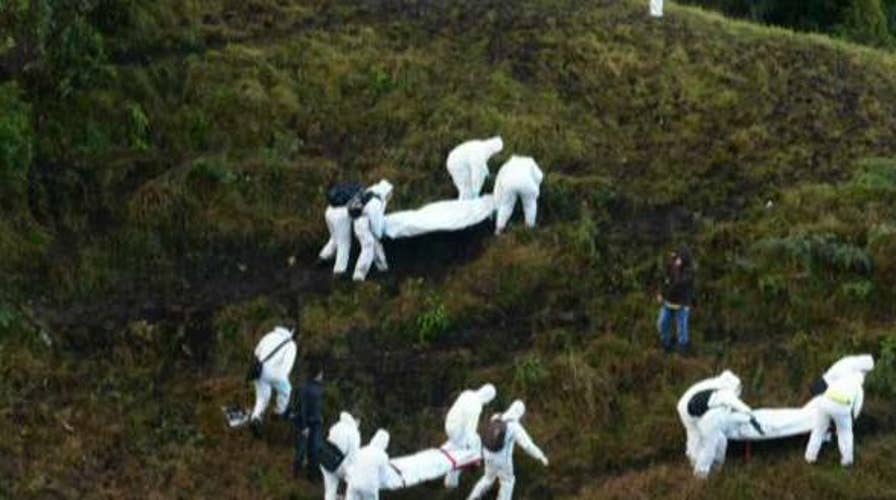MEDELLIN, Colombia – The pilot of the chartered plane carrying a Brazilian soccer team told air traffic controllers he had run out of fuel before crashing into the Andes, according to a leaked recording of the final minutes of the doomed flight.
In the sometimes chaotic audiotape from the air traffic tower, the pilot of the British-built jet could be heard repeatedly requesting permission to land due to a "total electric failure" and lack of fuel, before slamming into a mountainside late Monday.
A female controller could be heard giving instructions as the aircraft lost speed and altitude about eight miles from the Medellin airport. Just before going silent the pilot said he was flying at an altitude at 9,000 feet.
Related Stories...
The recordings, obtained by several Colombian media outlets, seemed to confirm the accounts of a surviving flight attendant and a pilot flying nearby who overheard the frantic pleas from the doomed airliner. These, along with the lack of an explosion upon impact, point to a rare case of fuel running out as a cause of the crash of the airliner, which experts say was flying at its maximum range.
For now, authorities are avoiding singling out any one cause of the crash, which killed all but six of the 77 people on board, including members of Brazil's Chapecoense soccer team traveling to the Copa Sudamericana finals. A full investigation is expected to take months and will review everything from the 17-year-old aircraft's flight and maintenance history to the voice and instruments data in the black boxes retrieved Tuesday at the crash site on a muddy hillside.
Alfredo Bocanegra, head of Colombia's aviation agency, said that while evidence initially pointed to an electrical problem, the possibility the crash was caused by lack of fuel has not been ruled out. Planes need to have enough extra fuel on board to fly at least 30 to 45 minutes to another airport in the case of an emergency, and rarely fly in a straight line because of turbulence or other reasons.
Before being taken offline, the website of LaMia, the Bolivian-based charter company, said the Avro RJ85 jetliner's maximum range was 2,965 kilometers (1,600 nautical miles) — just under the distance between Medellin and Santa Cruz, Bolivia, where the flight originated carrying close to full passenger capacity.
It is also possible the pilot dumped fuel, or a lack of fuel was caused by a leak or some other, unexplained reason.
"If this is confirmed by the investigators it would be a very painful because it stems from negligence," Bocanegra told Caracol Radio on Wednesday when asked whether the plane should not have attempted such a long haul.
One key piece to unlocking the mystery could come from Ximena Sanchez, a Bolivian flight attendant who survived the crash and told rescuers the plane had run out of fuel moments before the crash. Investigators were expected to interview her on Wednesday at the clinic near Medellin where she is recovering.
"'We ran out of fuel. The airplane turned off,'" Sanchez told Arquimedes Mejia, who helped pull the flight attendant from the wreckage. "That was the only thing she told me," he told The Associated Press in an interview.
Investigators also want to speak to Juan Sebastian Upegui, the co-pilot on an Avianca commercial flight who was in contact with air traffic controllers near Medellin's Jose Maria Cordova airport at the time the chartered plane went down.
In a four-minute recording that appears to be an audio message to a friend, Upegui described how he heard the doomed flight's pilot request priority to land because he was out of fuel. Growing ever more desperate, the pilot eventually declared "May Day! May Day!" because of a "total electrical failure," Upegui said, before the plane quickly began to lose speed and altitude in an almost three-minute death spiral.
"I remember I was pulling really hard for them, saying 'Make it, make it, make it, make it,'" Upeqgui says in the recording, which circulated on social media. "Then it stopped...The controller's voice starts to break up and she sounds really sad. We're in the plane and start to cry."
Another clue is the crash site itself, where no traces of fuel have been found. Often planes go up in a ball of flames upon impact but one reason six passengers survived was because the plane didn't explode.
John Cox, a retired airline pilot and CEO of Florida-based Safety Operating Systems, said the aircraft's amount of fuel deserves a careful look.
"The airplane was being flight planned right to its maximum. Right there it says that even if everything goes well they are not going to have a large amount of fuel when they arrive," said Cox. "I don't understand how they could do the flight nonstop with the fuel requirements that the regulations stipulate."

